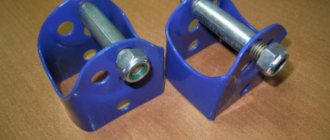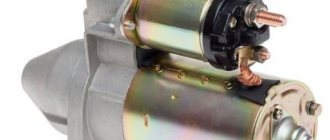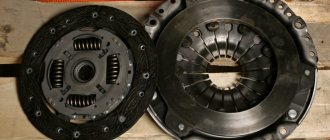In mid-2016, AvtoVAZ officially abandoned the use of manual transmissions from the French manufacturer Renault. The reason is the high cost of the “product” and the lack of a base for maintenance.
If domestic gearboxes cost 20–25 thousand rubles, then imported ones reached 45–50 thousand. Obviously, such a rise in price automatically increased the cost of the car as a whole. Perhaps because of this factor, many car enthusiasts preferred a model with a classic automatic or robotic option.
However, there are those who claim that the quality of production of domestic new mechanics (21087) is inadequate. They are ready to pay an additional 30,000 rubles for the French version. Let's compare the Renault JH3 (JR5) manual transmission and the VAZ 21087 manual transmission.
Specifications
| Name | Renault JH3 (JR5) | Manual transmission - 21087 |
| type of drive | Wire rope | |
| Number of speeds | 5 | |
| Main couple | 3,9 | |
| Gear ratio | 3,87 | 3,94 |
| Acceleration to “hundreds” | 11,2 | 10,2 |
| Maximum speed (km/h) | 175 | 188 |
| Fuel consumption (l/100 km) | 6,9 | 7,5 |
| Gear ratios for each gear | 3,636; 1,950; 1,357; 0,941; 0,784 | 3,727; 2,048; 1,393; 1,029; 0,795 |
Installing a shorter main pair increased the dynamics of acceleration, taking one second from the French “brand”. Adjusting the gear ratios for each gear made the transitions to higher gears smoother, without jerking, and dynamic.
Brakes: TRW brand, made in the Czech Republic, Poland, Italy, France, Turkey
In order for the Lada Vesta to stop properly, manufacturers from almost half of Europe had to work hard. In total, we counted five countries producing the braking system, including French SNR bearings pressed into the rear brake drums (integrated with the hub) of the German ATE brand, but of Italian production. When it is necessary to replace the bearing, it will be extremely difficult to remove it separately - most likely, you will have to change the entire assembly. Although the name of the SNR brand, which is premium by the standards of the world of auto components, inspires hope for durability.
So, the brake master cylinder and vacuum booster came from Poland, the front calipers and pads came from the Czech Republic. Some of the brake hoses turned out to be made in Turkey by Teklas. One of the features is that there is one brake system reservoir for two with a clutch drive.
The only question regarding the brakes arose when considering the front pads, on which there was a working mark of the cylinder - a quarter of the pressing surface extends beyond the pads. It is difficult to say whether this somehow affects the braking efficiency. While driving, we had no complaints about the braking system.
You will also have to tinker with the suspension elements during repairs. According to “foreign” patterns, the ball (produced by the BelMag Magnitogorsk plant) comes assembled with a lever. Moreover, replacing a component will require a lot of additional actions to free up space around it. By the way, according to servicemen, play of ball joints and knocking of stabilizer struts are the most frequent complaints from the first owners of Vesta.
Shock absorbers are one of the few Vesta components on which we did not see the “Aglitsky language”. The racks were produced at the Skopinsky Automotive Assembly Plant in the Ryazan region. By the way, in terms of the balance of suspension characteristics, we recognize Vesta as one of the best in the class.
We saw the only “Made in China” inscription on the windshield wiper motor from Bosch, with the logos of another automaker - the Chinese company Chery
Design and diagram of manual transmission on Lada Vesta
| Name | Data |
| Type | Mechanics |
| Factory index (article) | 21087 |
| Drive unit | Front |
| Engine capacity | 1,8 |
| Torque | 170 Nm |
| Default oil type | ZIC GFT 75W-85 |
| Oil volume | 2,2 |
| Lubricant replacement | Every 75,000 km |
| Filter update | Likewise |
| Average service life before major overhaul | 180000 km |
| Compatibility | Lada Vesta, X-RAY with engine capacity 1.6 / 106 hp., 1.8 / 122 hp. |
Related link:
How to reset fuel consumption on a Lada Vesta.
Checkpoint operation diagram
To find out the transmission type of your car, look at the VIN code:
- GFL11: mechanics;
- GFL12 - AMT box;
- GFL13 ─ mechanics from Renault.
Variable speed drive
And, of course, fans of the Tolyatti auto industry are looking forward to the appearance of the promised CVT in 2022. According to preliminary information, a variator with an imitation of 7 steps will first be offered in combination with the Nissan 1.6L HR16 engine, since we are talking about the Jatco JF015E transmission, which is designed for torque up to 160 Nm. It is quite possible that in the future the CVT continuously variable transmission will be gradually adapted to its own 1.8L engine.
The advantages of a CVT over an AMT are obvious. This is, first of all, the convenience of speed control. Cars with CVT pick up speed especially smoothly, without jerks or dips. They have a smoother ride and more dynamic acceleration than AT cars. The CVT is significantly quieter and more economical than classic torque converter transmissions.
“Pros” and “cons” in comparison with an automatic machine (robot)
| Advantages | Flaws |
| Acceleration dynamics have become better, the car picks up speed faster | Increased fuel consumption in the combined cycle |
| The car is 30 - 35 thousand cheaper when purchased with a manual transmission | Crunching, creaking when driving at low speeds |
| Long service life | |
| Cheapness of spare parts and components | |
| The car is more expensive on the secondary market compared to the robotic version | |
Generator: Valeo brand, made in Türkiye
The generator of the same French brand Valeo, but already made in Turkey, confused us at first - instead of the usual orange transformer varnish, the windings are covered with protection that is not uniform in color. However, as they say, “the speed should not be affected.” But we consider the fact that the terminals from the winding were not soldered, but simply crimped, to be a disadvantage. Not durable.
In addition, dismantling the component (replacement) is extremely difficult due to its location. The generator is clamped by the air conditioning compressor from below and its tubes - from the end and from the top, and from the belt drive side, as well as the tension roller, by the wall of the engine compartment. As a result, when replacing the generator, you will have to remove the air conditioning compressor (if there is one, of course).
Malfunctions and ways to eliminate them
| Malfunctions | Troubleshooting Methods |
| Transmission howl at 2000 – 3000 rpm | Insulation lining for gearbox control cables |
| Knock at idle | Replacing the pressure bearing |
| Critical wear of gears and teeth | Replacement with new ones, cannot be restored |
| Oil leaks from seals are less common. | Replacement of sealing seals with new ones. Overhaul of gearbox |
Fuse box and its housing: Renault brand, made in Romania
The fuse box comes entirely from the Logan model, as evidenced by the Renault logos on the body and the Romanian manufacturer Capirom. True, AvtoVAZ reported that in the near future the company will change its supplier to a local one - from the Samara region.
We had no questions about the unit itself, but in the process of a scrupulous study by the electricians, a very interesting point emerged. Attention was drawn to two fuses that were not indicated either on the diagram or in the instructions. A study of the electrical circuit revealed that during a sudden voltage surge (for example, when lighting up a Vesta with the engine running), these fuses may burn out, resulting in the battery stopping charging. And what’s most insidious is that the driver of a discharged car will not know about it - no electrical “paths” to the dashboard (indicator lamps) could be found. Whether the reason will be revealed when connecting the standard diagnostic system in the absence of an error that pops up is also a question.
The controls also turned out to be imported - the steering rack is from the famous German brand ZF, but made in Malaysia. And the CV joints are provided by the British company GKN and made in Poland.
Service life - from the factory and actual
The manufacturer in the operating instructions indicates an average interval of 180,000 km before major repairs. In fact, the mechanics last up to 200,000 km, provided that the manufacturer’s recommendations for care and maintenance are followed.
At the stage of using mechanics, breakdowns associated with depressurization of the system, oil leakage, and wear of the pressure bearing are most often recorded. Malfunctions are insignificant, not critical, and can be eliminated in a few hours of work by technicians at a service station.
Conclusion
The manual transmission under the factory code 21087 is a real technological breakthrough of domestic engineers. The transmission turned out to be not only more powerful, but also faster. At the same time, fuel consumption increased by 0.5 liters.
“Mechanics” has its advantages and disadvantages compared to the robotic version. Therefore, before purchasing, carefully analyze the technical characteristics of each type of gearbox.
Related link:
How to make Lada Vesta SW Cross even better - examples of tuning
From personal experience I will say the following:
- The mechanics are most adapted for active use on rough terrain.
- The robotic version, “automatic”, is mainly used for high-speed modes.
Gearbox AMT 2182
AMT (automated manual transmission) is a development of a Russian manufacturer that is worthy of attention. The box is controlled by an electromechanical drive, which is perfectly suited to domestic climatic conditions. Unlike hydraulic analogues, the box does not “freeze” in winter and does not require warming up before driving. The electronics cope perfectly with all the commands of the control unit, relieving the driver of tasks such as pressing the clutch pedal and changing gears. The only drawback of AMT can be considered slow gear shifting, which is clearly not suitable for those who like to “put pressure to the floor.”
In the production of the AMT 2182 gearbox, the VAZ-2180 manual transmission was taken as a basis. The box was equipped with a primary shaft rotation speed sensor and a gear shift control system from the German company ZF.
The designation GFL12 in the VIN code indicates that a “robot” is installed on the car.
Thanks for subscribing!
Reviews
| № | Positive |
| 1. | Dmitry , 33 years old (drive2.ru): they can’t say anything bad about the mechanics, the gearbox works properly. The car is only a year old, I regularly undergo maintenance, I don’t drive, I drive carefully. |
| 2. | Vyacheslav Petrovich , 47 years old (prom.ua): in a year and a half I drove about 20,000 km, mileage is above average. Impressions of the new mechanics are only positive. There is something to compare with; before this there was the Lada Granta. Grantmakers understand what I'm talking about. |
| 3. | Alexander Alekseevich , 43 years old (drom.ru): after buying the car, I changed the transmission oil for the first time at the 7000 km mark. I didn’t wait for 75,000 km, as the manufacturer recommends. The waste was of a natural color, metal shavings were present, but their quantity was insignificant. I did the same. |
| 4. | Alexey Petrovich , 48 years old (rozetka.ua): I’ve heard numerous negative reviews about the mechanics, I can’t confirm. I believe that the technical condition and performance of the unit depends on the driver. I don’t have any problems with this, I take care of my equipment. |
| 5. | Semyon Vyacheslavovich , 40 years old (Auto.ru): This is the second year since I bought and actively use a Lada Vesta on the mechanics. The review is positive, there are no comments about the work. |
| 6. | Vasily Timofeevich , 43 years old (Auto.Mail.Ru): for a year and a half of using a car with mechanics, he once made an unscheduled visit to a service station for diagnostics. I was at fault for the hum in the manual transmission, but it was the suspension. I hope that the device reaches the 180,000 km specified by the manufacturer. |
| 7. | Dmitry Gennadievich , 41 years old (drive2.ru): I like the mechanics more than the robot, I drove the AMT for three months, I can compare. Both robot and automatic are not adapted for domestic roads. The units do not last long, so it is better to buy a manual transmission. |
| 8. | Sergey , 35 years old (drive2.ru): on the mechanics, as soon as I pressed the pedal, I pressed it. And overtaking, and maneuverability, without kickdowns, delays in switching. Choice: definitely mechanics. |
| Negative | |
| 9. | Dmitry Semenovich , 52 years old (prom.ua): no matter how hard we tried, a miracle did not work. We decided to save several tens of thousands, but for the wrong reasons. It would be better to make the plastic cheaper than to install a Russian gearbox instead of a French one. Knocking and noise in the manual transmission was detected at 40,000 km. With such a low mileage there are such significant defects. |
| 10. | Gennady , 46 years old (Bibika.ru): after 30,000 km, cases of clutch slipping, delays when changing to higher gears, and howling of the gearbox became more frequent. You need to go to a workshop and order diagnostics. Couldn’t it have been done better from the start? |
| 11. | Boris , 38 years old (drive2.ru): at 25,000 km a gearbox whine appeared on a Lada Vesta. The officials said that the pressure bearing needs to be changed, but this is not certain. The final diagnosis will be announced after a comprehensive diagnosis. |
| 12. | Sergey Gennadievich , 45 years old (Avtodispatcher.ru): a knock in the gearbox was detected already at 31,000 km. Initially the fault was with the suspension, but after diagnostics the technician assured me otherwise. |
Related link:
Comparison of Lada Vesta and KIA Rio. Can a Russian-made car be a worthy competitor to popular foreign cars?
Engine: VAZ brand, made in Russia
Under the hood of the Lada Vesta there is a 1.6-liter 16-valve naturally aspirated 4-cylinder engine. Power - 106 hp. With. at 5800 rpm, torque - 148 Nm at 4200 rpm. Compliance with Euro-5 standards. The engine received the marking 21129, although the designation 21126 is clearly visible on the block itself. There is no need to be surprised, since all modifications of the engine (126/127/129), which trace its history back to Priora, have a single block.
Features: original suspension system and attachments; the intake and exhaust system has been changed; adaptation for the installation of a Renault gearbox, as well as about 20 other innovations, including a lightweight connecting rod and piston group made in Tolyatti by Federal Mogul.
A test drive of Vesta showed that the engine has very good output and elasticity, but is a little noisy at high speeds.
The engine fits right into the engine compartment of the Vesta. Access to all attachments is extremely limited. The entire engine is literally shrouded in wires - during the disassembly process I had to disconnect about 40 connectors and, with some difficulty, pick out a whole bag of fasteners.
The oil filter (Avtoagregat, Russia) is sandwiched between the subframe and the exhaust manifold, and it is not protected from the latter by any heat shield, which raises some concerns. The drive belt and its tension pulley practically rest against the inside of the body, just like the timing mechanism, so replacing them is only possible with a complete disassembly of the front right side of the car, dismantling the right additional side member and hanging the engine.
The officials confirmed to us other information that we suspected, but did not check ourselves. Due to the fastening features, removal of the engine sump (crankcase) is only possible with the removal of the gearbox.
Various plastic parts
There is already such a diversity of companies and manufacturing countries that it makes no sense to single out anyone separately, so we’ll just list them.
The air filter and its housing turned out to be from the famous German brand Mann+Hummel, and of original production. The electric fuel pump module assembly (with an Arsan pump) is Russian. The radiator expansion tank hose is from Teklas, but not from Turkey, but from Bulgaria. Washer reservoir with Renault logos, Continental washer pump, made in the Czech Republic.
With the exception of the aforementioned Czech microclimate control unit, the plastic interior parts turned out to be Russian, in particular Izhevsk. Moreover, the quality of fastening (hence the country of production) of individual small parts could be determined by touch - they were either loose or fell out at the slightest touch.
There was also a Russian approach: the plastic frame of the gear lever (Italian-Russian company AE2) that was not “shrunken” was sharpened on the inside (apparently with a file) along the edge. The side plug of the front panel (on the side of the front right door) bounced off like a spring at the first attempt to snap it off (what voltage was it installed under?).
Taking into account some other flaws in the interior assembly in the form of naked screws and gaps, it is worth saying that the interior of the Lada Vesta is generally better assembled than can be expected from most modern Ladas, but it is felt that over time, part of it will traditionally “come to life”. By the way, at first glance we liked the interior assembly of the almost entirely imported Lada XRAY more.
Some time ago, the Avtostat agency published the full list of component suppliers - there are also a dozen foreign brands that we have not mentioned. Some of them, by the way, did not coincide with the real ones - in particular, the tires on our Vesta were Pirelli, not Continental.











